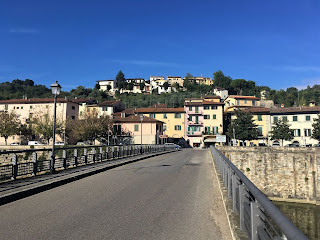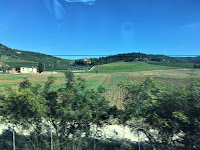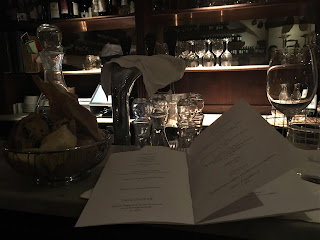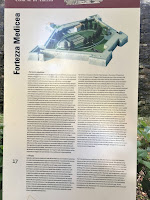In short, it was the many-sided, engaging and pleasant journey around the beautiful land of Tuscany. During 10 days I have visited 12 cities and towns, and according to my smartphone I have made 230000 steps (or 160 kilometres) on foot. The memorable places, which I definitely would like to visit again, are Bagni di Lucca, Lucca and Siena. Florence, with its outstanding architecture, rich history and picturesque landscapes, is another exceptional city, that will be certainly in my heart forever.
Traveling is an important part of my life and I appreciate all happy moments which I experience when visiting remarkable places and meeting incredible people. Maybe one day some of these stories will inspire others to begin their own memorable and exciting adventures..
Thursday, 10 October 2019
Wednesday, 9 October 2019
Italy, The Best Pizza
I was rather lazy in the morning, so I stayed in bed as much as possible and did not take time to stroll around Incisa as it was planned yesterday. Eventually, I set off at 10 am to the train station, from where I departed to Florence.
Actually, I had no time to stay in Florence, because I had to hurry to the airport.
I arrived to the central station of Pisa in one hour. Now it is only 2 kilometres to the airport, and I decided to make this short trip on foot. Meanwhile, I felt hungry, thus I located the nearest pizzeria with Maps.Me application. It was "Fratelli D'Auria". People at this family-run restaurant do not speak English at all. However, even the language barrier did not prevent me from ordering a pizza. And it was the best pizza I have ever tasted during my trip! It was another example of the fundamental truth, that the best local food can be found on the edge of a town.
Well-fed and absolutely satisfied I got to the airport. My backpack perfectly fitted into the baggage sizer in spite of the purchased sweets and tangerines. I believe, I could buy additional kilos of cheese, which is very limited in my country these days, but I did not.
Finally, I was on board, and in a few hours I came back to Moscow.
Tuesday, 8 October 2019
Italy, Florence's Views
Today I have a trip to Florence by bus. The route from Incisa to Florence was across the hills and on the hills, and it offered the incredibly breathtaking views. This was a serpentine road, but the woman, who was driving a bus, was obviously in hurry. So, the journey was amusingly thrilling.
There was countless number of people in the streets of Florence, specifically on the Signoria square and in front of the Uffizi gallery. And this is a typical picture for the most beautiful city in Italy. For example, roughly 15.4 million tourists stayed in the city in 2018. Luckily, I do not have in my plans to visit any museum and to stay in the long queue today. My primary goal for now is getting to the Michelangelo piazella, located on a hill on the south bank of the Arno river.
Actually, the bus 12 from the centre (you can find it at the train station, near the taxi stand) goes directly to the Michelangelo square. However, if you need to get back, you should take bus 13.
Still, the walking path up to the hill is magnificent, so I decided to have this short trip on foot. You can start the route up to Piazzale Michelangelo from Piazza Poggi at Porta San Niccolò.
Another hurdle in the form of staircase, and finally I will be on the piazza. This staircase is a favorite place for those who like observing the sunset while drinking a glass of excellent Italian wine. Of course, I took the time to sit on the steps with other travelers.
In fact, it is the most famous observation point to enjoy the panorama of the city in all its splendor. You may have a clear view of a number of the city's most important landmarks, including the Duomo, Ponte Vecchio and Palazzo Vecchio. No wonder that once it was a very popular and fashionable meeting place for the Upper middle class of the 19th century.
Many mistakenly believe that the piazza existed since the birth of Florence, or that it was designed by Michelangelo. Actually, it was created in 1869 by Florentine architect Giuseppe Poggi, as part of major restructuring of the city walls. Poggi's terrace was initially intended as a showcase for Michelangelo's masterpieces, at least copies. These days only the replica of Michelangelo's David is placed here. The bronze statue is set on a large pedestal, decorated with replicas of allegorical statues depicting day, night, dusk and dawn. At the same time, the original marble statue of David can be seen in the Galleria dell'Accademia, but the original allegorical statues are in the Medici Chapels of the San Lorenzo Basilica.
Another place of extraordinary beauty is Giardino delle Rose (or "The rose garden"), just below the Piazzale. From here you also can admire an amazing view over the city sitting on the grass. And the entrance is absolutely free. I believe, the best time to visit this garden and to enjoy its beauty is in the spring when the roses are at their best.
The sun is getting down, and I turned back, following the same path as I was getting to the Michelangelo piazella.
It was a great walking. I think, after such a physical exercise I deserved a good dinner. Yesterday I was strongly advised to visit the restaurant Il Santo (Piazza Santo Spirito, 66R), which in the evening opens at 7:30 pm. Be prepared, that you will encounter a long queue at the entrance, so it is a good idea to book a table in advance. However, I was lucky enough to occupy a seat at the bar counter. Honestly, it was the best restaurant in Tuscany I have visited so far, in terms of service, atmosphere and food.
In short, it was the perfect ending of the day in the best city of Italy.
Monday, 7 October 2019
Italy, Arezzo city
In the morning I set off for the city Arezzo, which was recommended to me by my hostess Verena. The road from Incisa took about 1 hour by train.
Arezzo may boast a long and rich history that dates to Etruscan times. Nowadays the city is well known for its shopping with clothes, home-wear, jewelry and antique.
Arezzo may boast a long and rich history that dates to Etruscan times. Nowadays the city is well known for its shopping with clothes, home-wear, jewelry and antique.
The good thing about Arezzo is that few tourists come to this part of eastern Tuscany. Meanwhile, Arezzo can offer a wide range of sites, including fortresses, monuments, churches, and museums, which all give the visitors a chance to step back into history. There are even the remains of a Roman amphitheater here!
Arezzo's long history is tied to its unique geographical position, a strategic point between the Po Valley, the Mediterranean Sea and Adriatic Sea, and the Tuscan city-states.
Arezzo was founded as an Etruscan city in the 9th century BC. It was a flourishing commune in the Middle Ages, but it fell to Florence in 1384 and later became part of the grand duchy of Tuscany. After a short period of French rule during the Napoleonic Wars, the rule of the Habsburg grand dukes was restored until Arezzo became part of Italy in 1861.
What makes Arezzo interesting is that its cathedral is quite different to the style of Duomos in other famous Tuscany cities such as Florence or Siena. Whereas they are built in the characteristic white and black marble, the Arezzo Cathedral is a much more humble-looking building. However, there are several interesting art pieces inside, such as the Maddalena fresco, the coloured stained glass and the baptismal font with the reliefs sculpted by Donatello.
In the upper part of the town it is located the Medici Fortress. Built between 1538 and 1560, the fortress was once an impressive five-point structure. Although the stronghold is now just a reminder of the past, you can get a 360-degree view of Arezzo and the surrounding area from atop its walls.
The heart of Arezzo is Piazza Grande. This handsome Medieval square is deservedly one of the city’s main attractions, and it was even used in the Oscar winning film “Life is Beautiful”. Piazza Grande is also a great place to relax and have lunch, without the crowds that usually fill the squares of tourist destinations. The famous loggia, which once hosted artisan stalls, is now home to trattorias and coffee shops. Moreover, on the first weekend of every month Piazza Grande becomes the grand setting for the most popular Antiques Fair in Tuscany.
The extremely notable building on the main square is the church Chiesa di Santa Maria della Pieve. Oddly enough, it backs onto the square rather than facing it.
The Romanesque church has been built between the XII and XIII century and features a striking facade with columns all differing one from the other and a beautiful bell tower. The three-tiered facade and the bell tower have earned this church the name “tower of a hundred holes” due to its many windows.
Arezzo is a nice town, but I have walked it through in 3 hours, so the rest of the day I have decided to spend in Florence.
In Florence, first of all, I headed to the Piazza del Duomo, where the impressive Cathedral of Santa Maria del Fiore is located. This church is also known as il Duomo, and it serves as the city's symbol, which is probably the most recognizable building in Florence.
Santa Maria del Fiore is dedicated to the Virgin of the Flowers. Built on the 4th-century remains of the original cathedral, Santa Reparata, it was initially designed by Arnolfo di Cambio in 1296. The Duomo is 502-feet long, 295-feet wide and 295-feet high, and it was the largest church in the world until the completion of Saint Peter's Basilica in Vatican City in 1615.
Next to the cathedral there is placed a majestic bell tower. Clad in white, red and green marble it considered to be the most beautiful campanile in Italy. Probably, it was designed more for decorative than for functional purposes. The construction of the tower was begun by Giotto in 1334, and nowadays it has the name of this eminent architect.
Another remarkable place in Florence is the Piazza della Signoria. It was two years ago when I visited Florence for the first time (there was also a blog about this journey). At that moment, the imposing Fountain of Neptune, situated on the square in front of the Palazzo Vecchio, was under reconstruction. However, today I have opportunity to see this beautiful piece of art with my own eyes.
Made of marble and bronze, the fountain was commissioned in 1565 and designed by Baccio Bandinelli. The colossal sculpture of the God of the sea in a chariot drawn by four horses is surrounded by three young newts and four figures representing Doride Oceania with the daughter Nereide Teti and two sea Gods. The statue is also known as the Biancone (great white) on account of the brilliance of its marble.
Another mandatory activity while visiting Florence is walking across the historic bridge Ponte Vecchio ("old bridge" in English). In fact, the Ponte Vecchio is the oldest bridge in Florence, and it was the only bridge across the Arno River until 1218.
Interestingly, there have been shops on the bridge since the 13th century, but by the 1400s the bridge was overwhelmed with butchers, fishmongers, tanners and other merchants who produced a lot of noise, unpleasant odors and waste. So, in 1593 Ferdinand I de' Medici, decided that only goldsmiths and jewelers would be allowed to have shops on the bridge. Today, the "Gold Bridge" is known in the world over for its characteristic wooden doorways and shop windows overflowing with jewels and gold.
In short, Florence has the reputation of the living museum, where every street, alley, building is full of history and amusing facts. No wonder, that it is considered to be the best city in the world. Luckily, I have two more days to spend time at this marvelous city.
Subscribe to:
Comments (Atom)





















































